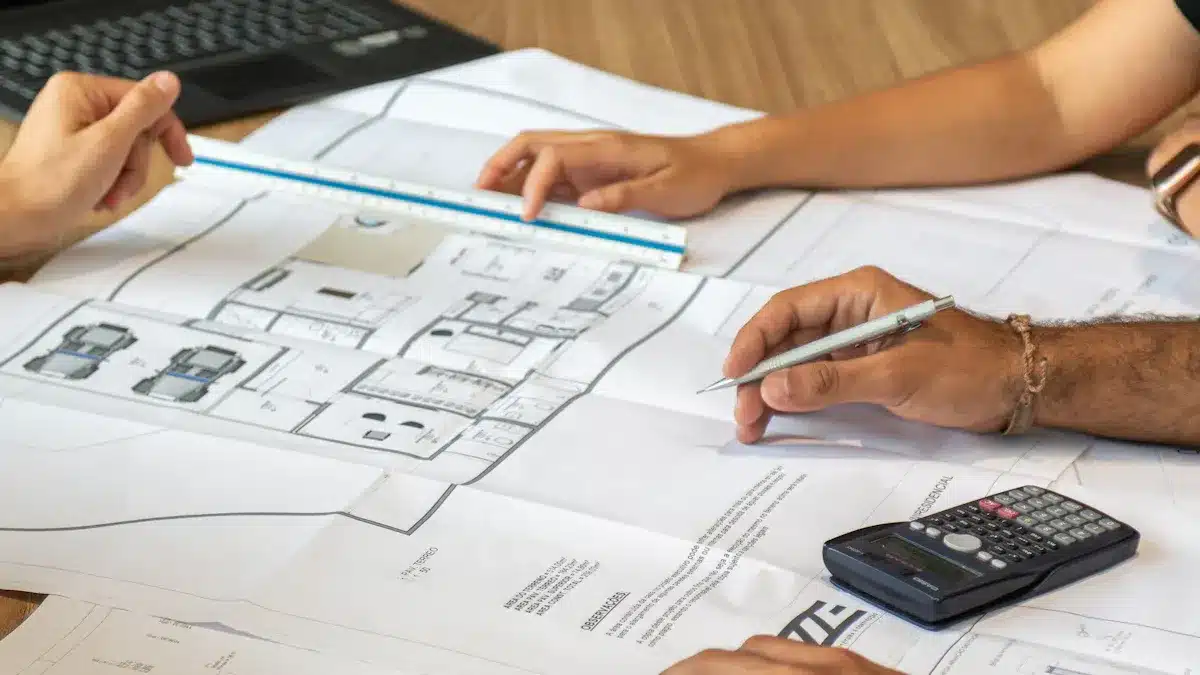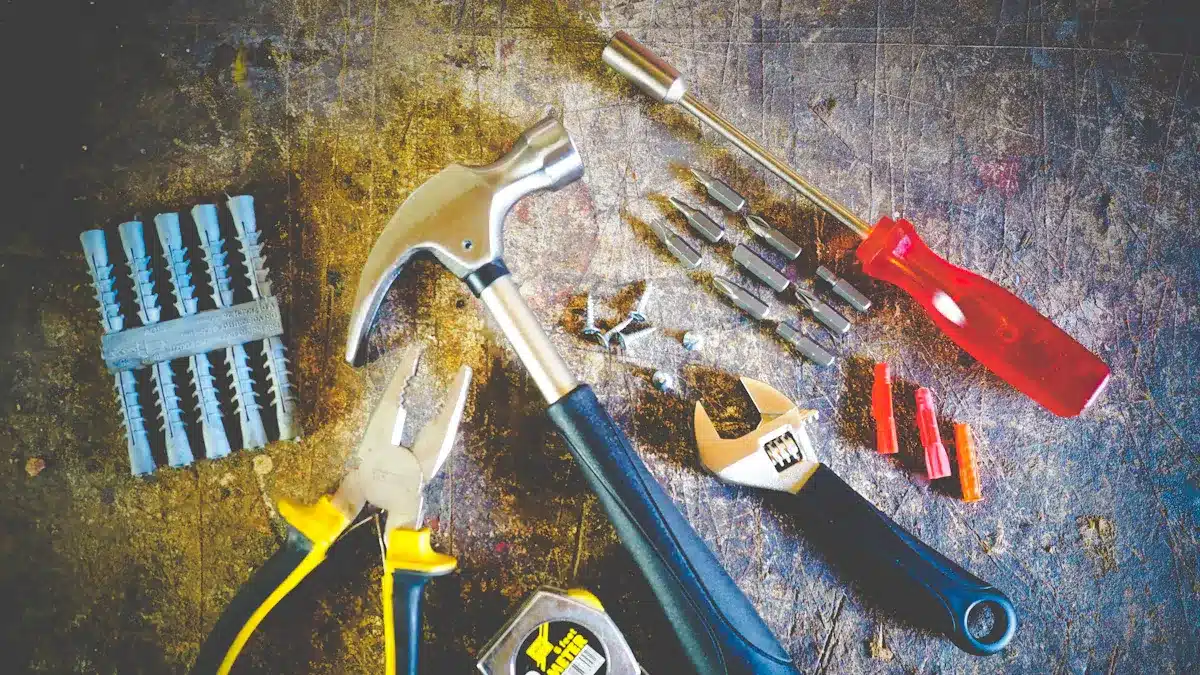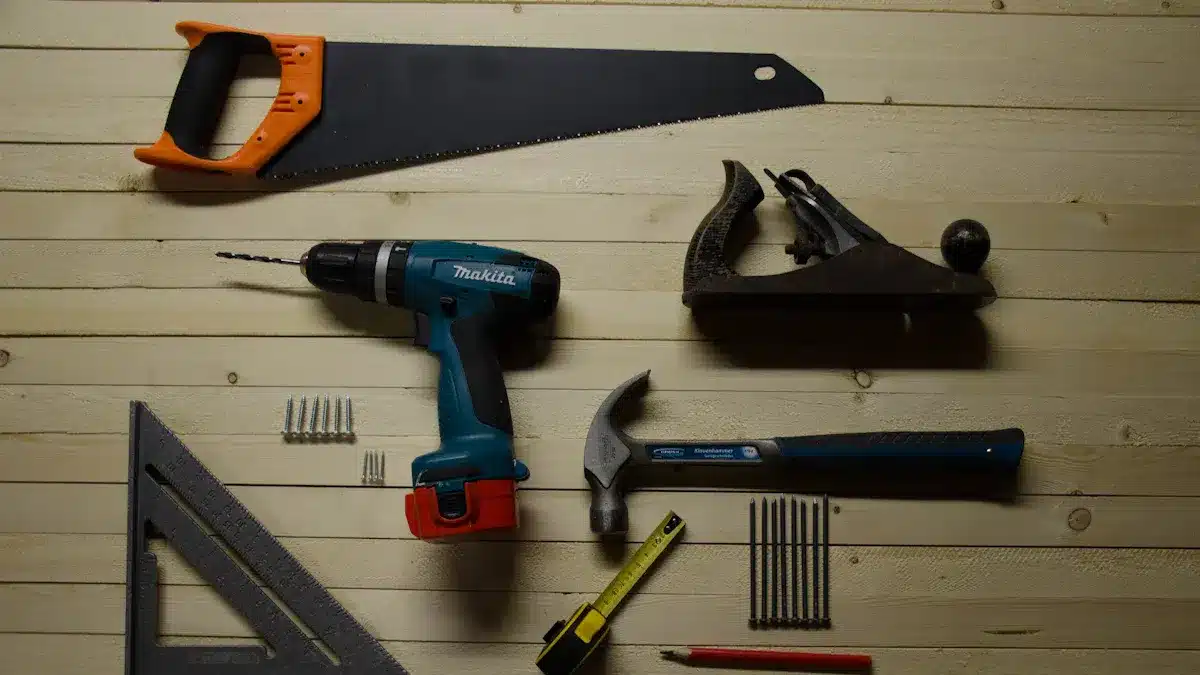
Choosing the right build board products is very important for your projects. Quality, strength, and cost matter a lot in this choice. For example, strong materials keep your structure safe. Durable options can cut maintenance costs by 30%. You should think about the environment too. Eco-friendly materials can lower emissions by 40%. These things can really affect your project’s success and budget.
Key Takeaways
Picking the right build board products is very important for project success. Think about quality, strength, and cost to keep things safe and strong.
Foam boards are light and flexible. They are great for crafts and building models. They are easy to cut and resist moisture.
Plywood is strong and stable. It works well for heavy projects. It is also affordable and does not bend or twist easily.
MDF has a smooth surface and can be customized. It is good for detailed woodworking. It is cheap but can swell if it gets wet, so be careful with it.
Special boards like MagPanel® are eco-friendly and fire-resistant. They are good for many building uses.
Foam Board Options

Foam boards are popular for many projects. They are especially good for crafting and architectural modeling. These boards are lightweight and can be used in many ways. Let’s look at the features and benefits of foam board products.
Features and Benefits
Foam boards come in different types. Each type has its own special features. Here are some important features that make them great for your projects:
Lightweight: Foam boards are easy to carry and move. This makes them perfect for small and big projects.
Versatile: You can use foam boards for many things. This includes art projects, model structures, and signs.
Easy to Cut: You can cut foam boards easily with a utility knife. This helps you make precise shapes and sizes.
Moisture Resistance: Some foam boards, like XPS, resist moisture better. This makes them good for wet places.
Here’s a table that shows popular foam board types and what they are used for:
Foam Board Type | Description | Common Uses |
|---|---|---|
Standard Foam Board | Lightweight, cheap, and flexible; made of polystyrene with paper covering. | Art projects, model structures, mood boards. |
Foam Core Board | Similar to standard foam board; often used the same way. | Showcasing artwork and photographs. |
Specialty Foam Boards | May include types for special uses (e.g., thicker boards). | Architectural models, craft projects. |
Pros and Cons
Using foam boards has good and bad points. Here’s a quick look:
Advantages | Disadvantages |
|---|---|
Durable: They resist bending and curling. | Vulnerable to outdoor elements: Not good for long outdoor use. |
Lightweight: Easy to carry and set up. | Susceptible to wear and tear: Handle carefully to avoid damage. |
Easy to use: Simple to cut and print on. | |
Versatile: Comes in many finishes (glossy, textured, matte). |
Foam boards are often used in architectural modeling. They help show detailed designs. They help people see how buildings will look and how things will fit together. White foam boards are liked for their easy cutting and shaping. They are great for professional models. Gatorfoam boards are strong and good for big models and displays.
In signage, foam core boards work for both short-term and long-term needs. You can use them for signs that give directions, safety signs, and decorations in offices. Their light weight makes them easy to hang and show.
However, some users have common complaints. Problems like air leaks and moisture can happen if foam boards are not sealed well. Also, lower-quality boards may break down over time, making them less useful.
Plywood Choices

Plywood is a useful material for many projects. It is made of thin layers of wood glued together. This design makes plywood strong and stable. There are different types of plywood, each with special features and uses. Let’s look at the main features of plywood.
Key Features
Plywood has several important features that make it popular with builders and DIY fans:
Strength and Stability: Plywood can hold heavy weights. Its layers help it resist bending and breaking.
Moisture Resistance: Some types, like marine plywood, resist water damage. This makes them good for outdoor work.
Aesthetic Appeal: Hardwood plywood has nice grain patterns. You can use it for furniture and decoration.
Cost-Effectiveness: Plywood usually costs less than solid wood. It gives you good value for your money.
Here’s a table that shows different types of plywood and what they are used for:
Type of Plywood | Characteristics and Applications |
|---|---|
Three-Ply | Flexible and useful, great for lightweight projects like DIY furniture and decorative panels. |
Five-Ply | Strong and stable, used in building for shelves, cabinets, and medium-duty tasks. |
Multi-Ply | Very strong for heavy-duty jobs like flooring and structural parts. |
Marine Plywood | Waterproof and resistant to rot, used in boatbuilding and outdoor furniture. |
Aircraft Plywood | High-strength and lightweight, used in aviation and high-performance jobs. |
ApplePly® | Premium hardwood plywood known for stability, used in making furniture and cabinets. |
Structural Plywood | Made for strength, great for load-bearing jobs like sheathing and subflooring. |
Hardwood Plywood | Made from hardwood layers, durable and nice-looking, used in furniture and decorative work. |
Softwood Plywood | Cost-effective, used in building for roof sheathing and wall panels. |
Advantages and Disadvantages
Using plywood has good and bad points. Here’s a quick look:
Advantages:
Strength: Plywood is strong and stable. It works well for building projects.
Resistance: It resists shrinking, bending, twisting, and cracking. This makes it a dependable choice for many jobs.
Versatility: You can use plywood for many things, including decking and furniture.
Cost-Effective: Compared to solid wood, plywood is cheaper. It makes good use of wood resources.
Disadvantages:
Cost: While plywood is cheaper than solid wood, it can cost more than MDF.
Splintering: Plywood may splinter when moved. Handle it carefully to prevent damage.
Moisture Issues: In wet or outdoor areas, plywood can swell, separate, or get moldy.
When thinking about the best decking materials, plywood is a great choice. For example, CDX plywood is affordable and strong, making it good for general building and decking. Marine plywood is the best quality and durability, perfect for marine uses and outdoor decking.
MDF Products
MDF stands for Medium Density Fiberboard. It is a popular choice for many build board projects. You will see it used a lot in cabinets, furniture, and decorations. Its special features make it a great option for different tasks.
Unique Features
MDF is special because of several important traits:
Smooth Surface: MDF has a perfect texture without knots or grain. This helps paint go on evenly and allows for detailed engravings.
Cost-Effective: It costs less than solid wood but still has great quality and strength.
Versatile and Customizable: You can cut, shape, engrave, and paint MDF easily. This makes it good for many artistic projects.
Durability and Strength: MDF is very stable. It does not warp or crack, so your projects stay strong over time.
You will often find MDF in custom cabinets for kitchens, bathrooms, and living rooms. Its even density and resistance to warping make it a dependable choice. Also, MDF is popular for interior doors, baseboards, crown molding, and other trim work, giving a nice finish.
Pros and Cons
Using MDF has good and bad points. Here’s a quick look:
Pros | Cons |
|---|---|
Cost-effective because it uses waste products | Lacks the natural beauty of solid wood |
Comes in different thicknesses | Absorbs water quickly, causing swelling |
Smooth surface is great for finishing | Weak material, needs support |
Consistent material without grain issues | Can crack and split |
Less warping in humid conditions | Contains VOCs, which can be harmful |
While MDF is a good choice for many projects, you should know its limits. It can swell from moisture and may chip or get damaged on the edges. Proper installation and care can help reduce these problems. Overall, MDF is still a top choice among build board products, especially for detailed woodworking and painting.
Cardboard Materials
Cardboard is a useful material for building models and light projects. You can use it for many things, from simple designs to detailed models. It is light, so it is easy to carry. It is also cheap, which lets you try new ideas without spending too much money.
Features and Benefits
Cardboard has many features that make it good for different projects:
Lightweight: You can easily move and work with cardboard models.
Cost-effective: Cardboard usually costs less than other materials, so it saves money.
Easy to Cut and Shape: You can use sharp tools to make exact cuts for detailed designs.
Recyclable: Many types of cardboard are eco-friendly, helping the environment.
Here’s a table that shows different types of cardboard and what they are used for in model building:
Model Type | Purpose | Characteristics |
|---|---|---|
Conceptual Models | Explore building shapes and layout during early design stages | Simple, abstract shapes made quickly for fast testing and idea development |
Working Models | Focus on specific parts like exteriors or interiors | More detailed models that help fix problems before real construction |
Presentation Models | Show real-world settings for client meetings | Very detailed, including landscaping and small features |
Pros and Cons
Using cardboard has good and bad points. Here’s a quick look:
Advantages | Disadvantages |
|---|---|
Lightweight | Less Durable |
Cost-effective | Damage from Moisture |
Good for Printing | Limited Weight Support |
While cardboard works well for many projects, it has some limits. For example, moisture can make it weak. You might want to use thicker cardboard for better strength. Corrugated fiberboard is a popular choice because it is strong yet light. It is easy to cut, bend, and fold, making it great for sturdy models.
Specialty Build Boards
Specialty build boards have special benefits for different projects. One great product is MagPanel® MgO Boards. This new material can take the place of regular options like plywood and gypsum wallboards. Its strength and fire resistance make it good for inside and outside use.
Features and Applications
MagPanel® has many features that make it useful:
Eco-friendly: This product can be recycled and has no harmful chemicals like ammonia or formaldehyde.
Fire-resistant: It keeps you safe in construction, making it perfect for places needing fire protection.
Versatile: You can use it for many purposes, such as:
Feature/Application | Description |
|---|---|
Cladding | Gives strength and support for inside and outside coverings. |
Subflooring | Offers a strong, sustainable base for flooring installation. |
Wall Sheathing | Serves as a fire-resistant base for siding, roofs, soffits, and fascias. |
Structural Insulation Panels | Excellent for structural insulation panels (SIPs). |
You can use specialty build boards in many building and DIY projects. They are great for making strong decks, walls, and even furniture. Their special features make them a top choice for builders wanting the best decking material.
Pros and Cons
Like any material, specialty build boards have good and bad points:
Advantages:
Durability: They resist damage, making them last a long time.
Fire Safety: Their fire-resistant quality adds extra protection.
Sustainability: Eco-friendly choices help lower your carbon footprint.
Disadvantages:
Cost: Specialty boards can cost more than regular materials.
Availability: Some products may not be as easy to find as standard options.
Comparison of Build Board Products
When you look at different build board products, think about some key features. These features help you make smart choices based on what your project needs. Here’s a summary of important features to compare:
Overview of Key Features
Feature | Description |
|---|---|
Security | Important for keeping board communications and documents safe. |
Scheduling Tools | Helps manage meetings and reminders easily. |
Online Directory | Gives quick access to contact info and details about board members. |
Document Storage | Safe cloud storage for sharing and managing documents securely. |
Mobility | Allows access to board features on different devices while keeping them secure. |
These features are very important in deciding which build board product is best for your project. For example, if you need a product for outside use, think about moisture resistance and strength. If you are making a detailed model, focus on how easy it is to cut and shape.
Quick Reference for Selection
To help you pick the right build board product, here’s a quick reference table that sums up the most important things to think about:
Factor | Description |
|---|---|
Payback Period | Shows how long it takes to get back your initial investment; shorter times are usually better, but ongoing costs and income potential should also be looked at. |
Discounted Cash Flow Analysis | Looks at future income value, taking into account inflation and demand decline; good projects make money long after they are done. |
Net Present Value (NPV) | Compares current project costs with returns; a higher, positive NPV is better, considering the time value of money. |
Opportunity Cost | Thinks about total project costs, including resources, time, and training, not just financial numbers. |
Non-Financial Considerations | Includes effects on the environment, social impacts, and how well it fits with company values; these can be hard to measure against financial numbers. |
Internal Rate of Return (IRR) | Shows profitability by comparing IRR across projects with similar start-up costs; a higher IRR means a more profitable investment. |
Scoring Models | Gives numerical values to important criteria, allowing for a comparison of project proposals based on how well they meet organizational goals. |
This table gives a clear view of what to think about when choosing a build board product. By focusing on these factors, you can make sure you pick the best decking material for your project needs. Whether you want composite decking or other materials, knowing these elements will help you make the right choice.
Picking the right build board products is very important for your projects. Each material has its own special features and benefits. Foam boards are light and can be used in many ways. Plywood is strong and stable. MDF has a smooth surface and is easy to use. Cardboard is cheap and great for models. Specialty boards like MagPanel® are strong and good for the environment.
Think about what your project needs. Look at the features of each product. This way, you can make smart choices that help you succeed.
FAQ
What is fiber-cement siding?
Fiber-cement siding is a strong material for homes. It is made from cement, sand, and cellulose fibers. This type of siding resists bad weather, pests, and fire. That’s why many homeowners like to use it.
How does PVC decking material compare to wood decking?
PVC decking is better at resisting moisture and bugs than wood decking. It needs less care and lasts longer. This makes it a smart choice for your backyard deck.
What are the benefits of using the best fiber-cement siding?
The best fiber-cement siding is very durable and needs little maintenance. It comes in many styles too. It also helps increase your home’s value, making it look nicer.
Can I use fiber-cement products for outdoor projects?
Yes, you can use fiber-cement products outside. They handle tough weather well and resist rot. This makes them great for siding and other outdoor uses.
Why should I choose PVC over traditional siding materials?
Choosing PVC siding has many benefits. It needs less maintenance, doesn’t fade easily, and lasts longer than traditional materials. It is also good for the environment and can be recycled.
See Also
Choosing the Right PCBA Manufacturer for Your Business
Essential Advice for Selecting the Ideal Main PCBA
Finding the Perfect RF PCBA Company for Your Needs
Selecting the Right PCB Prototype Manufacturer for Your Project